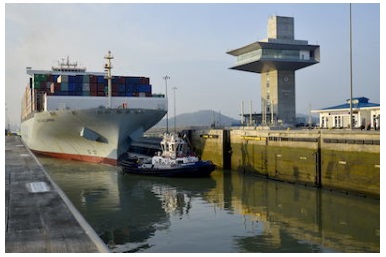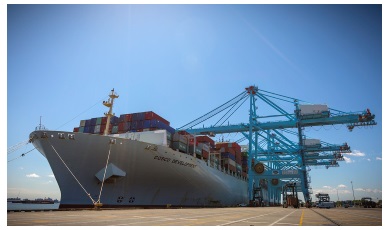Liner Shipping: North Carolina, Virginia
![]() Print this Article | Send to Colleague
Print this Article | Send to Colleague
Container carrier StreamLines recently added Wilmington to its Blue Stream weekly service and will begin calling the North Carolina port in June.
"The addition of the Port of Wilmington to the rotation allows StreamLines the opportunity to service North Carolina’s important and ever growing sweet potato export market," said StreamLines General Manager Pablo Gonzalez. "Furthermore, we open the Carolinas to one of the fastest and most direct services from Central America."
Blue Stream uses five vessels with high reefer container intake on a weekly rotation that includes ports in Europe, the Caribbean, Central America and the United States. Since its introduction in January 2016, the service has become an important transportation link for shippers moving perishables seasonally and year-round from Central America to the United States and Europe and from the southeastern United States to Europe.
The full rotation is: Puerto Limón (Costa Rica), Puerto Barrios (Guatemala), Puerto Cortés (Honduras), Port Canaveral, Wilmington (NC), Tilbury (UK), Rotterdam (Netherlands), and the Radicatel terminal on the River Seine between Rouen and Paris.
Advertised transit times from Wilmington are 9 days to Tilbury, 10 days to Rotterdam and 11 days to Radicatel.
First in the string to call Wilmington will be the 2,127-TEU container ship Georgia Trader on June 5.
StreamLines is the fourth container service announcement at the Port of Wilmington in the last three months. Like the others, the ports authority believes Blue Stream container service could draw more agricultural traffic to the Port of Wilmington Cold Storage (PWCS) facility.
The demand for sweet potatoes in Europe is particularly high and it is anticipated that the new Blue Stream container service, dovetailed with the capabilities of the PWCS facility, will give North Carolina farmers the opportunity to grow their export business to Europe through North Carolina Ports. On the import side, new refrigerated services will support shipments of fruits and vegetables to North Carolina’s grocery sector.
"As we continue to expand our footprint, we see the trade lane between the southeastern United States and Europe as an emerging market for us," said Chief Commercial Officer Greg Fennell of the North Carolina State Ports Authority "We’re revamped to accommodate the large, post-Panamax ships but we also see opportunity for niche players like StreamLines to sail in as we gain market share."
Virginia Welcomes Its Biggest Container Vessel Ever: The 13,000-TEU COSCO Development

COSCO Development transiting the Panama Canal en route to the Port of Virginia
Photo/Panama Canal Authority
The Port of Virginia® welcomed its largest containership ever with the May 4 docking of COSCO Development at Virginia International Gateway (VIG).
Delivered in 2011, COSCO Development has a length overall of 366 meters/1,201 feet, beam of 48.2 meters/158 feet, draft of 14.5 meters/48 feet, and deadweight of 140,609 metric tons. At 13,092-TEUs, its container capacity is nearly a third greater than that of the port’s previous record holder, the 10,000-TEU MOL Benefactor, which called Norfolk International Terminals (NIT) last summer.
"We’ve seen nothing like her here," said John. F. Reinhart, CEO and executive director of the Virginia Port Authority. "For years, we have been talking about the ‘next generation’ of vessels and the ‘big-ship era’. This is what we have been preparing for. The talk is over; the big ships are here."
During her 30-plus hour stay in Virginia, multiple labor shifts loaded and unloaded nearly 2,000 containers. On average, most vessels are there for 12-14 hours.
"What’s truly significant is that Virginia is this vessel’s first East Coast stop," Reinhart said. "This vessel is taking full advantage of our 50-foot channels and an expanded Panama Canal. As the ships get bigger there are corresponding cargo loads. So, our ability to quickly push these slugs of cargo inland by barge to Richmond Marine Terminal and double-stack rail to Virginia Inland Port and then into our markets in the nation’s heartland becomes even more important."
COSCO Shipping is part of the OCEAN Alliance, which also includes CMA-CGM, Evergreen Line and OOCL. COSCO Development operates in the alliance’s South Atlantic Express service and arrived in Virginia after transiting the expanded Panama Canal.
Deployed in this weekly Asia-to-U.S. East Coast service are 11 vessels ranging in size from 11,000 to 13,000 TEUs. The port rotation includes Hong Kong, Yantian, Ningbo, Shanghai, Panama, Virginia, Georgia and South Carolina and then back to China.
Reinhart said growing vessel sizes and accompanying cargo volumes are behind the port’s $670 million investment to increase overall annual throughput capacity by 40 percent – 1 million containers – by 2020.
Presently, heavy construction is underway at VIG and civil engineering work is nearing its start at NIT.
"We are adding capacity now so we can handle the cargo that will be coming to us on these vessels," he said. "The big ships are here — more are on the way – and they are carrying significant amounts of containers. To be sustainable and competitive for decades to come, we must be ready to accommodate that volume at our inland and water-side facilities."

COSCO Development at Virginia International Gateway Photo/Virginia Port Authority

